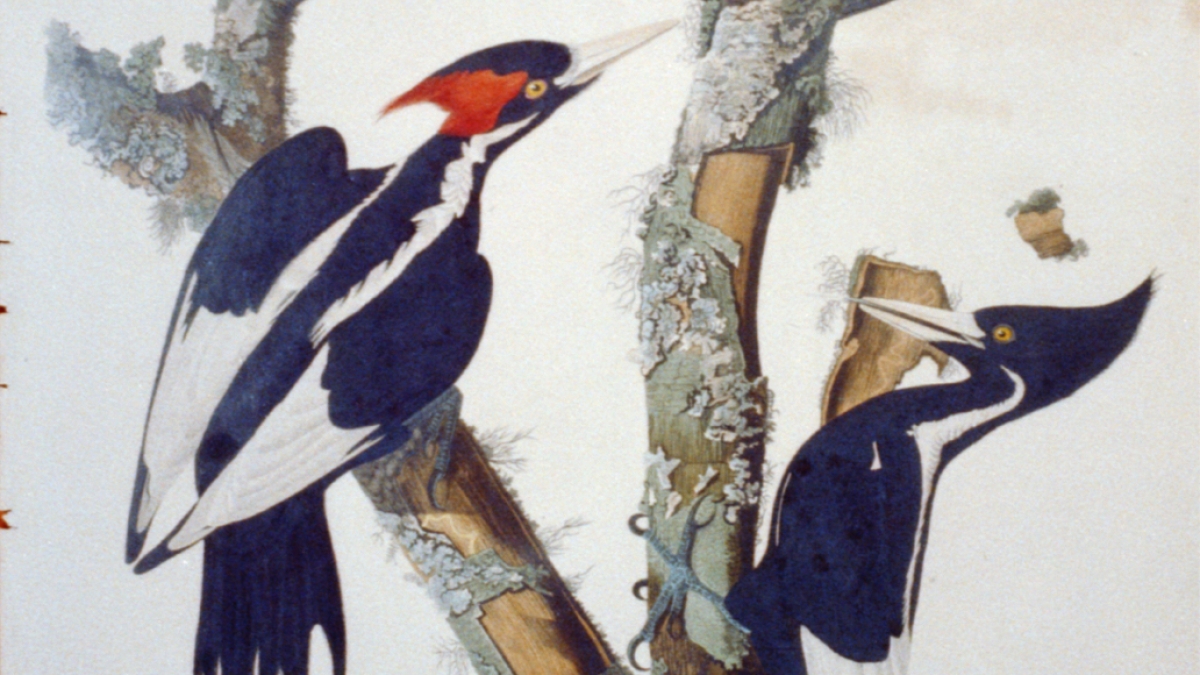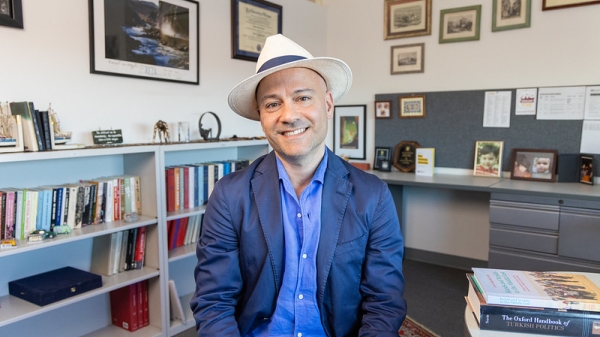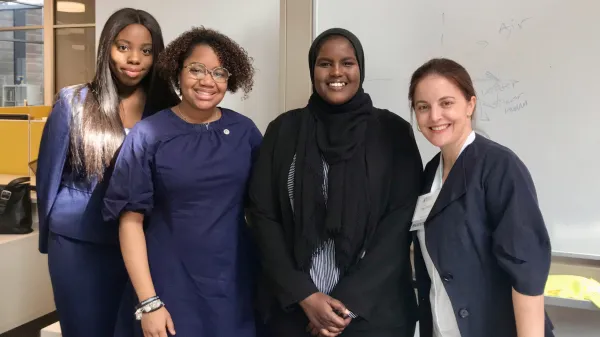How to save more species before they're gone forever
ASU conservation scientist calls for more funding of the Endangered Species Act to combat escalating biodiversity crisis

Last week, the U.S. Fish and Wildlife Service announced a delisting of 23 species that are believed to be extinct in the United States, joining about 900 species that have been documented as extinct around the world.
Even though the Fish and Wildlife Service produces this list annually, the numbers are becoming accelerated, according to Leah Gerber, a professor of conservation science in Arizona State University’s School of Life Sciences.
Climate change, exploitation of wildlife and pollution are among many of the reasons why animals and plants are often declared extinct.
“It’s unequivocal that we are using and overexploiting nature faster that it can recover,” said Gerber, who is also the founding director of the Center for Biodiversity Outcomes (CBO) at ASU. “Biodiversity is the foundation for our economy and well-being, yet it is declining at unprecedented rates.”
Gerber’s research and teaching work to advance the integration of science in decision processes to sustain Earth’s biodiversity in a time of rapid biophysical, institutional and cultural change. Gerber was recently a lead author for the Intergovernmental Panel on Biodiversity and Ecosystem Services Global Assessment, which provided the most comprehensive evaluation of the status of biodiversity and nature’s contribution to people in the U.S. and globally. This report concluded that in coming years, more than a million species will be threatened with extinction.
Following Gerber’s appearance on Monday’s NPR’s 1A and quote in the New York Times, ASU News spoke to Gerber about the Fish and Wildlife Service's extinction list, and how the current and future administrations need to address what she calls an emerging “biodiversity crisis.”
Note: Answers have been edited for length and clarity.
Leah Gerber
Question: This year’s Fish and Wildlife Service delisting of 23 species seems especially jarring because it includes the ivory-billed woodpecker, which was once known as the largest woodpecker in the United States. The list also includes the yellow-breasted Backman’s warbler and several Southeastern freshwater mussels. How does this impact you both as a scientist and a human?
Answer: These 23 species join the list of 11 species previously delisted due to extinction and hundreds of other species scientists estimate have been lost in the last 200 years. As a conservation scientist, I am committed to engaging the public in understanding ways that our actions have a direct impact on the biodiversity outcomes that we have seen and will continue to see in the future.
Extinction is permanent — and by losing woodpeckers, we have lost a natural form of pest control, and in losing mussels we have lost an important food source. All species contribute to human well-being, whether directly or indirectly. The loss of our natural heritage and planet’s biodiversity cannot be recovered. The impact is irreversible, and policy action is urgently needed to address the biodiversity crisis.
Q: I thought the Endangered Species Act of 1973 was designed for this sort of thing. Is the government not doing a good enough job regarding enforcement, or do they not have enough resources available to them — and how do we fix that?
A: Global biodiversity loss is occurring at an unprecedented rate, and halting this loss will require a significant increase in the level of conservation investment. Yet, funds for conservation are limited and priorities for investment must be set. Effective allocation to date has been hampered by the limited evidence linking investments and measurable biodiversity outcomes. In my 2016 PNAS paper, I have discovered that less than 25% of the $1.21 billion given per year with the purpose of implementing recovery plans is actually allocated to these recovery plans.
In the face of sparse resources, a structured, logical and transparent approach to allocating limited resources to recovery programs provides a way to maximize recovery of species. Choosing full recovery for some species does not entail deliberate extinction for others. The science of structured decision making, together with the development of decision-support tools — e.g., systematic conservation planning — provides approaches that require decision makers to clearly articulate objectives and constraints, and more transparently evaluate alternative allocation strategies to find the strategy that best meets multiple objectives.
The recent delisting announcement highlights the need to support federal agencies to employ such approaches and to fund the ESA to conserve species before declines become irreversible. The ESA is a necessary "crisis management" tool to save species when all else has failed. Without it, many more species would have been extinct, and biodiversity would be spiraling at a much more dramatic rate than it is now.
This past year, President Biden requested a more than $60 million increase for endangered species conservation, which is amazing because it is the largest increase request for this program in all of history. Alas, the House Appropriations Committee undercut the president’s budget request by $17 million, but $43 million is a good and essential start to help the cause. The ESA is not broken; it's starving for resources!
Q: What is contributing to the cause or causes of animal extinction?
A: Primary threats to biodiversity include climate change, habitat loss and modification, overexploitation of wildlife, invasive species and pollution. Today, about a million species are at risk of extinction globally. The majority of land and seas have been significantly modified by human activity; populations of wild species continue to decline; and ecosystem services — from disease buffering to pollination — are at risk of loss. I argue that conservation science has failed to achieve its fundamental goal of protecting biodiversity and we need new approaches. ASU’s CBO aims to bring together scholars from different disciplines to innovate new ways to solve the biodiversity crisis, and linking this scholarship to decision makers and managers.
Q: You were recently interviewed by the New York Times on this issue. You told them that a healthy environment is linked to strong social and economic systems, and you proposed financing opportunities and financial markets for biodiversity as promising approaches to measure and value biodiversity. Can you unpack some of this for me?
A: In the context of biodiversity conservation, innovative financing refers to market-based mechanisms that account for the value of biodiversity. Financial markets for biodiversity broadly includes managing capital and using financial incentives to support sustainable biodiversity management. Such markets may include private and public financial resources used to conserve biodiversity, investments in commercial activities that produce positive biodiversity outcomes and the value of the transactions in biodiversity-related markets such as habitat banking.
At present, 12% to 17% of the estimated $300 billion to $400 billion of investment needed annually to maintain global biodiversity currently flows to conservation finance, with most originating from limited public and philanthropic sources. Yet, institutional investors and other asset managers have more than $175 trillion in assets for global economic activity. There is thus opportunity to direct private capital towards conservation investments, despite the marketplace for such investments being slow to develop to date. A key hurdle is that there are no established mechanisms for investors to consider the value of nature and the consequences of their activities for biodiversity.
Q: You’ve also stated that this is a “public value failure” in conservation science. What do you mean by that?
A: The idea of public value failure comes from ASU's very own Barry Bozeman, who proposed the idea as a corollary to market failure. A market failure is an instance where the private sector and the market malfunctions and fails to do what we expect it to do — deliver economic value. A public value failure is an instance where the public sector and the government malfunctions and fails to deliver things that the public values, such as conservation. Just like we can look at a market failure and ask "what went wrong; why did this fail?" we can look at a public value failure and ask the same questions.
My research on actionable science in conservation with Derrick Anderson, Chris Barton and Candice Carr Kelman has approached this question, and we have come up with a couple of interesting answers. One finding is that a persistent gap exists between the generation of ecological knowledge and the application of this knowledge to solving pressing conservation challenges. There is an incongruence between what a recent paper called "the logic of inquiry" — which animates researchers — and the logic of action, which animates practitioners and policymakers. Those doing the research and those "on the ground" making policy or taking action are often working in different worlds and not communicating. Researchers produce knowledge for which there is no audience, and other stakeholders have questions which remain unanswered. There is a growing need for evidence-based approaches to conservation challenges, but the fact is that taking action does not require complete or accurate knowledge.
The logic of public value failure has yielded valuable insights on other realms of science and technology, and helped these fields effectively deliver public value. Viewing conservation failures as public value failures opens up a whole new toolbox for understanding the issues of conservation and, hopefully, rectifying them.
Q: In the coming years, more than 1 million species will be threatened with extinction. What will that mean for our planet and society, and how do we fix this?
A: At present, our main challenge is not trying to figure out what’s wrong; it’s about deciding to take action to address the problem. The science is clear about the biodiversity crisis, and we have options for solutions. We can start by looking to experience to figure out what works to conserve biodiversity.
To combat the biodiversity crisis, we will need to make this issue a higher national priority and establish a comprehensive federal response. We need a coordinated all-of-government approach to confront this problem at home so that we can avoid more extinctions like these. While multiple federal agencies are already tasked with protecting and conserving key aspects of biodiversity in the U.S., there is no coordinating policy to maximize these efforts or facilitate collaboration among them.
Indeed, U.S. congressional leaders are discussing an NBS (national biodiversity strategy) to guide national efforts to address the biodiversity crisis. I recently had the opportunity to deliver congressional testimony on the biodiversity crisis and the need for an integrated strategy, and our CBO Program Leads have partnered to propose a process to establish a strategy.
U.S. public support for conserving biodiversity continues to be strong, but a national strategy is unlikely to succeed if it relies solely on top-down policy or legislation, without incorporating inclusive, community-led approaches with input from all stakeholders. Arizona’s U.S. Sen. Mark Kelly is a proponent of the initiative and is particularly focused on ensuring that an effective and equitable NBS is developed through public engagement.
An NBS would help clarify the contributions of these essential elements to biodiversity conservation, through providing a coherent policy framework for comprehensively addressing the extinction crisis and other leading drivers of species decline. A National Biodiversity Strategy is a necessary complement to the America the Beautiful initiative and is the best chance we have ever had to reverse course and secure our planet’s rich biodiversity, for its own sake, for our immediate well-being and for future generations.
Top image: A color engraving of an ivory-billed woodpecker by John J. Audubon. Illustration courtesy of the Library of Congress
More Law, journalism and politics

CBS News president to give keynote address at Cronkite School’s spring convocation
Ingrid Ciprián-Matthews, president of CBS News, will serve as the keynote speaker at Arizona State University’s Walter Cronkite School of Journalism and Mass Communication spring 2024 convocation. …

School of Politics and Global Studies director's new book explores mass violence
Why do people commit atrocities and why are certain groups, including religious and ethnic, more vulnerable to large-scale violence? These questions are explored in a new book by Güneş Murat Tezcür…

ASU faculty contributing to improvement of Wikipedia
Many academics have a love-hate relationship with Wikipedia. While the website has information about almost anything you can imagine, the credibility of that information is sometimes suspect. Tracy…
